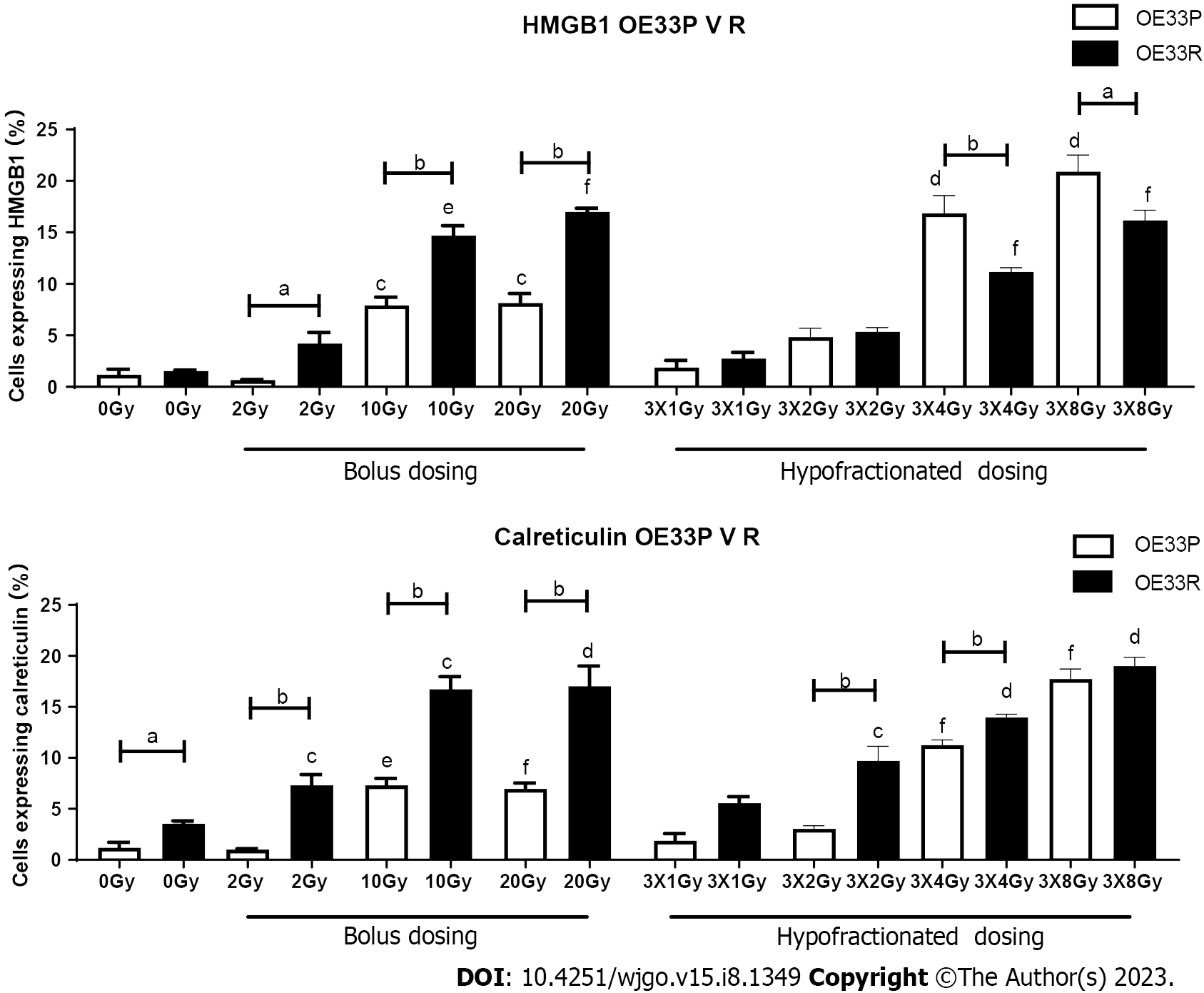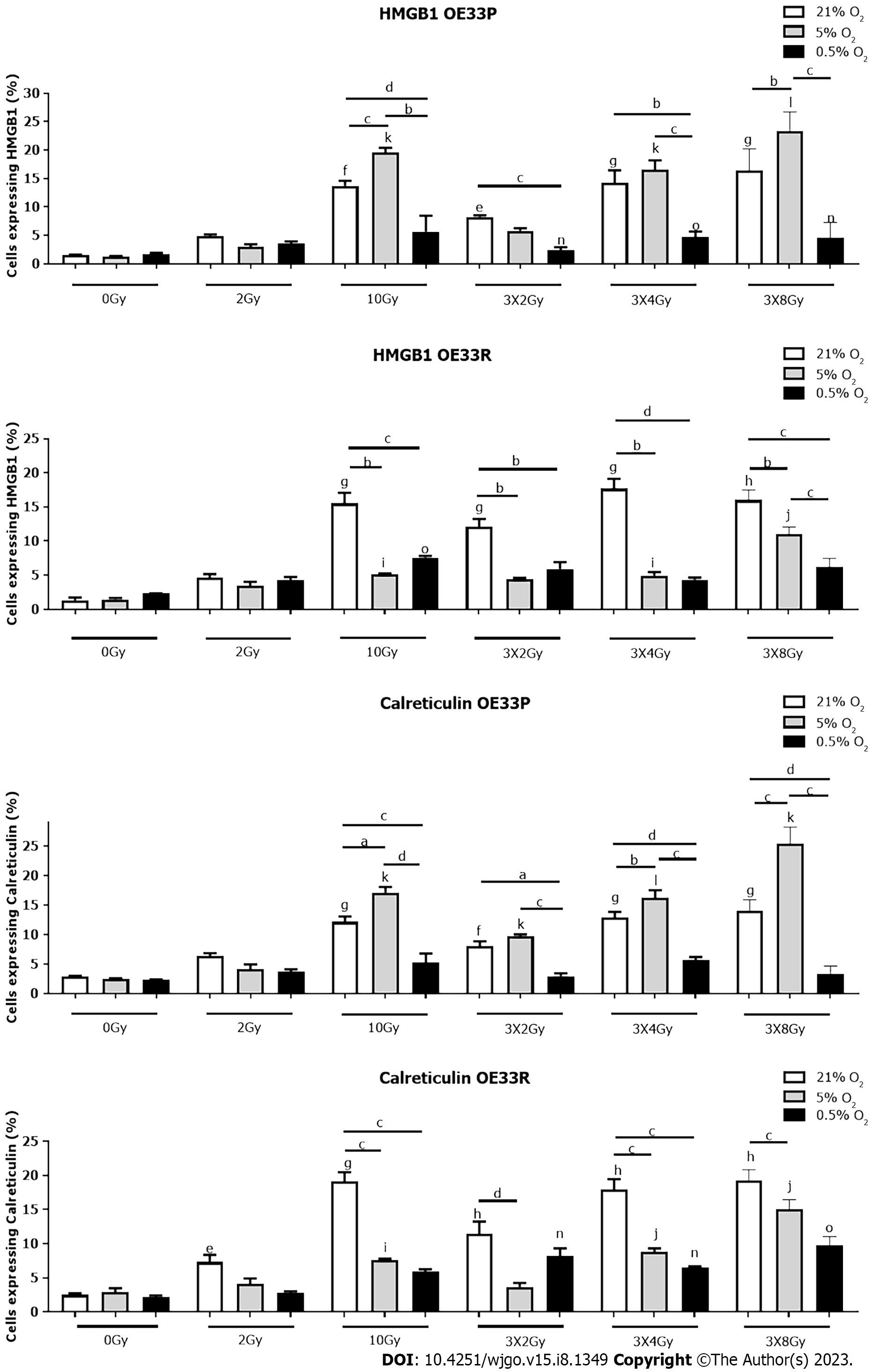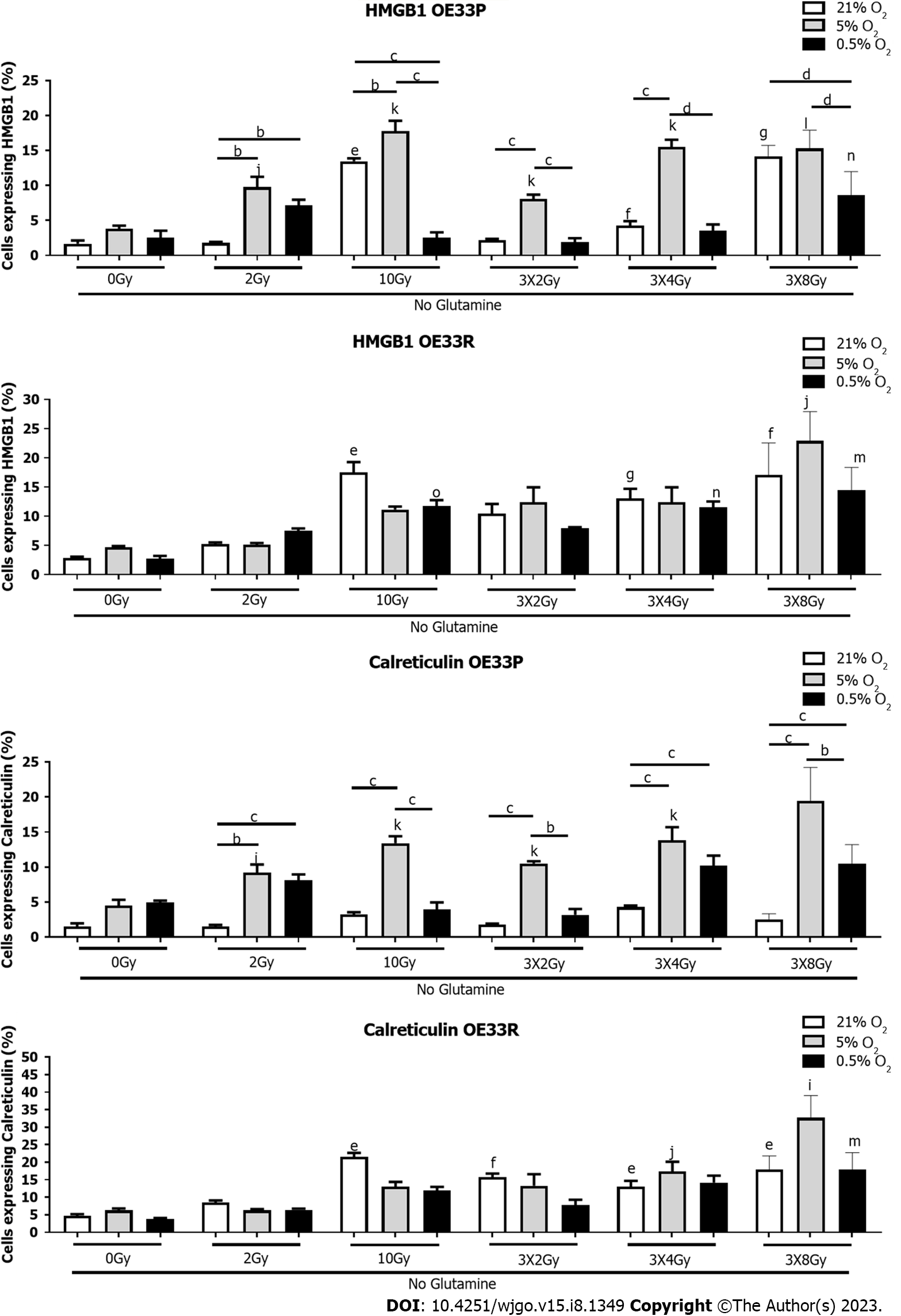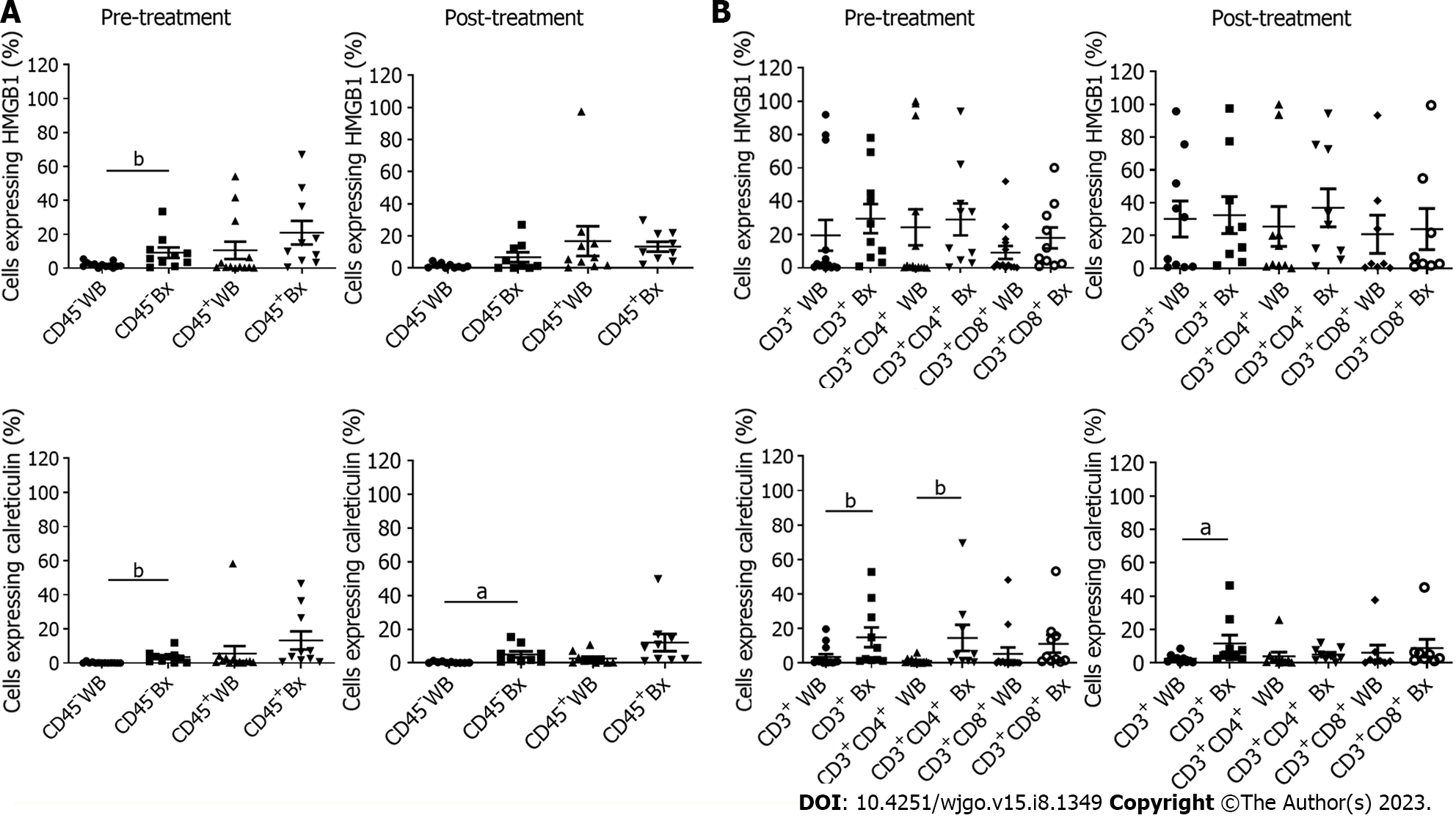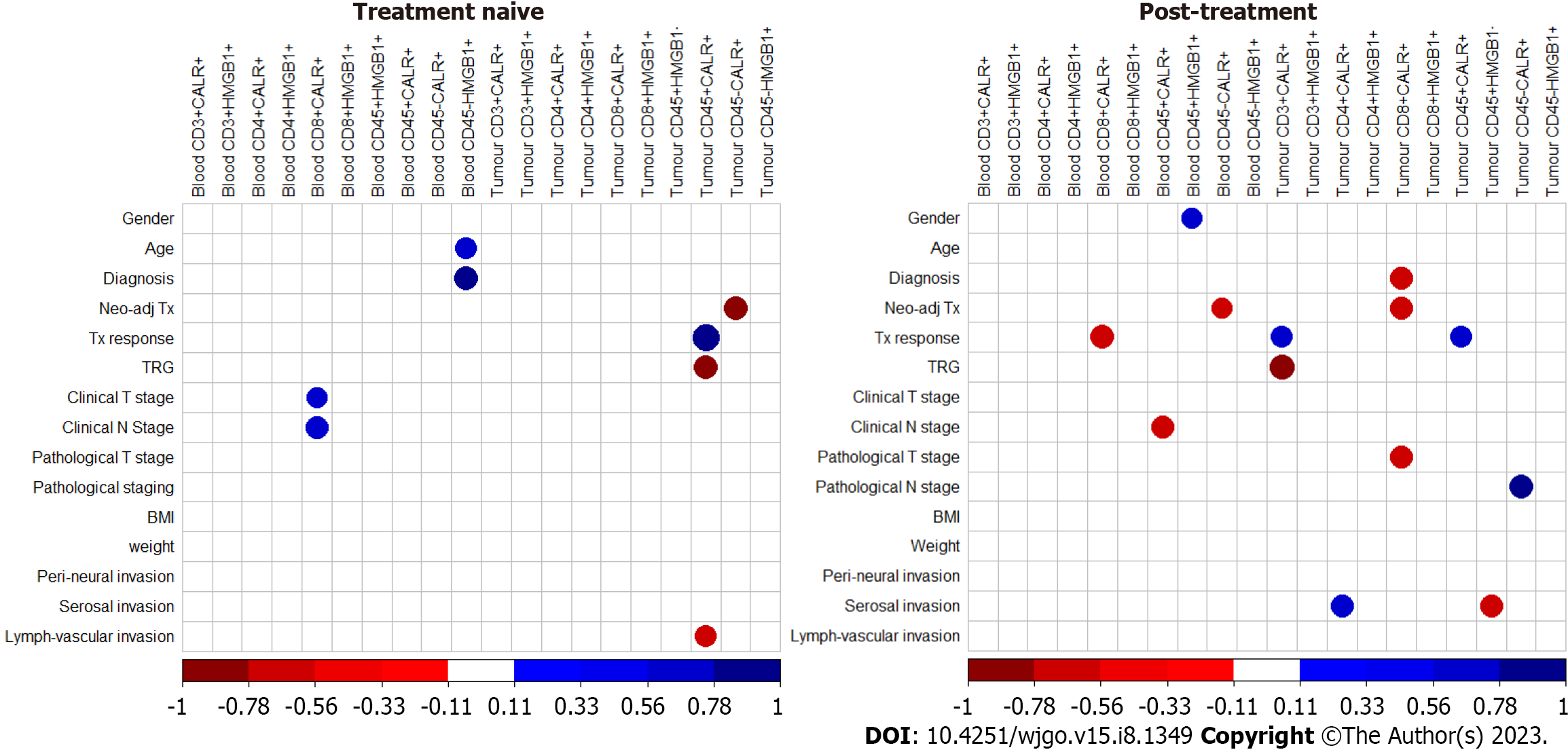Copyright
©The Author(s) 2023.
World J Gastrointest Oncol. Aug 15, 2023; 15(8): 1349-1365
Published online Aug 15, 2023. doi: 10.4251/wjgo.v15.i8.1349
Published online Aug 15, 2023. doi: 10.4251/wjgo.v15.i8.1349
Figure 1 HMGB1 and calreticulin are expressed at a higher level on the OE33R cell line compared to the OE33P cell line with bolus dosing and at higher levels on the OE33P cell line with fractionated dosing.
OE33P & OE33R cell lines were screened for the surface expression of HMGB1 and calreticulin by flow cytometry. Tukey’s multiple comparison testing. Graph shows % expression (± SEM) (n = 3). aP < 0.05, bP < 0.01 vs OE33P and OE33R; cP < 0.01, dP < 0.001 vs dosing with 0 Gy on OE33P; eP < 0.01, fP < 0.001 vs dosing with 0 Gy on OE33R.
Figure 2 HMGB1 and calreticulin are expressed at higher levels under 5% Oxygenation in the OE33P cell line, with a higher expression under normal oxygenation in the OE33R cell line.
OE33P and OE33R cell lines were screened for the surface expression of HMGB1 and calreticulin by flow cytometry. 21% = Normal oxygenation, 5% = mild hypoxia, 0.5% = severe hypoxia. Bolus dosing was administered once daily over three consecutive days. Staining of cancer cells took place 24 h after last fraction of radiation. Tukey’s multiple comparison testing. Graph shows mean % expression (± SEM) (n = 3). aP < 0.05, bP < 0.01, cP < 0.001, dP < 0.0001 vs oxygen levels for each radiation dosing regimen; eP < 0.05, fP < 0.01, gP < 0.001, hP < 0.0001 vs dosing with 0 Gy at 21% O2; iP < 0.05, jP < 0.01, kP < 0.001 vs dosing with 0 Gy at 5% O2; lP < 0.05, mP < 0.01, nP < 0.001 vs dosing with 0 Gy at 0.5% O2.
Figure 3 HMGB1 and calreticulin are expressed at a higher level under 5% oxygenation with no glucose in the OE33P cell line, with a higher expression of HMGB1 under normal oxygenation in the OE33R cell line.
OE33P and OE33R cell lines were screened for the surface expression of HMGB1 and CRT following culture in glucose depleted media by flow cytometry. 21% = normal oxygenation, 5% = mild hypoxia, 0.5% = severe hypoxia. Bolus dosing was administered once daily over three consecutive days. Staining of cancer cells took place 24hrs after last fraction of radiation. Tukey’s multiple comparison testing. Graph shows mean % expression (± SEM) (n = 3). aP < 0.05, bP < 0.01, cP < 0.001, dP < 0.0001 vs oxygen levels for each radiation dosing regimen; eP < 0.05, fP < 0.01, gP < 0.001, hP < 0.0001 vs dosing with 0 Gy at 21% O2; iP < 0.05, jP < 0.01, kP < 0.001 vs dosing with 0 Gy at 5% O2; lP < 0.05, mP < 0.01, nP < 0.001 vs dosing with 0 Gy at 0.5% O2.
Figure 4 HMGB1 and calreticulin are expressed at a higher level under 5% oxygenation no glutamine in the OE33P cell line.
OE33P and OE33R cell lines were screened for the surface expression of HMGB1 and calreticulin following culture in glutamine depleted media by flow cytometry. 21% = normal oxygenation, 5% = mild hypoxia, 0.5% = severe hypoxia. Bolus dosing was administered once daily over three consecutive days. Staining of cancer cells took place 24hrs after last fraction of radiation. Tukey’s multiple comparison testing. Graph shows mean % expression (± SEM) (n = 3). aP < 0.05, bP < 0.01, cP < 0.001, dP < 0.0001 vs oxygen levels for each radiation dosing regimen; eP < 0.05, fP < 0.01, gP < 0.001 vs dosing with 0 Gy at 21% O2; iP < 0.05, jP < 0.01, kP < 0.001 vs dosing with 0 Gy at 5% O2; lP < 0.05, mP < 0.01, nP < 0.001 vs dosing with 0 Gy at 0.5% O2.
Figure 5 Expression of damage associated molecular patterns on the surface of peripheral blood and tumour-infiltrating T cells.
The expression of HMGB1 and calreticulin was determined on the surface of peripheral blood and tumour-infiltrating A) CD45- and CD45+ cells and B) CD3+, CD3+CD4+, CD3+CD8+, in treatment-naïve and post-treatment OAC whole blood (WB) (n = 14 pre-treatment, n = 10 post-treatment) and tumour biopsy tissue (Bx) (n = 10 pre-treatment, n = 9 post-treatment) ex vivo by flow cytometry. Wilcoxon rank test, aP < 0.05, bP < 0.001. Treatments: FLOT n = 5 and CROSS n = 5.
Figure 6 Expression of damage associated molecular patterns on the surface of peripheral blood CD45+ and CD45– cells and T cells from matched pre and post-treatment oesophageal adenocarcinoma patients.
The expression of HMGB1 and calreticulin was determined on the surface of peripheral blood A) CD45+ and CD45- cells and B) CD3+, CD3+ CD4+, CD3+ CD8+ in matched pre and post treatment (CROSS regimen) whole blood (n = 5) ex vivo by flow cytometry. aP < 0.05.
Figure 7 Corrplots illustrating the correlation values for the expression and co-expression of damage associated molecular patterns in oesophageal adenocarcinoma blood and tumour pre and post treatment, correlated with clinical demographics and characteristics.
Patient clinical features included age, weight (pre-treatment, kg), BMI (pre-treatment, kg/m2), neo-adjuvant treatment received, treatment response (determined by radiographic features using PET/CT), tumour regression grade (TRG), clinical tumour stage and nodal involvement, pathological tumour stage and nodal involvement, BMI (post-treatment, kg/m2), weight (post-treatment, kg), serosal invasion and lymph-vascular invasion. Blue indicates a positive correlation, red negative correlation. Spearman correlation. Significant data shown only. Spearman r 0.4-0.59 moderate, 0.6-0.79 strong and 0.8-1 very strong. aP < 0.05.
- Citation: Donlon NE, Davern M, Sheppard A, O'Connell F, Moran B, Nugent TS, Heeran A, Phelan JJ, Bhardwaj A, Butler C, Ravi N, Donohoe CL, Lynam-Lennon N, Maher S, Reynolds JV, Lysaght J. Potential of damage associated molecular patterns in synergising radiation and the immune response in oesophageal cancer. World J Gastrointest Oncol 2023; 15(8): 1349-1365
- URL: https://www.wjgnet.com/1948-5204/full/v15/i8/1349.htm
- DOI: https://dx.doi.org/10.4251/wjgo.v15.i8.1349









